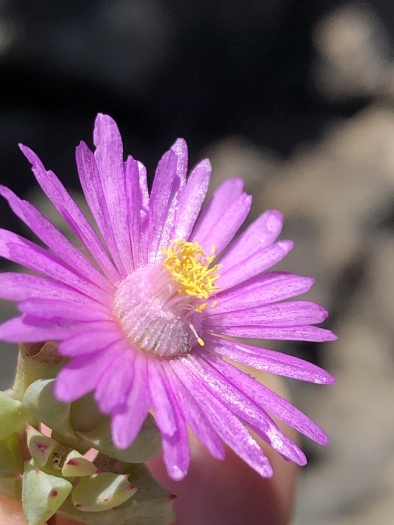Deltoid-Leaved Dewplant
(Oscularia deltoides)
Deltoid-Leaved Dewplant (Oscularia deltoides)
/
/

Dave U
CC BY 4.0
Image By:
Dave U
Recorded By:
Copyright:
CC BY 4.0
Copyright Notice:
Photo by: Dave U | License Type: CC BY 4.0 | License URL: http://creativecommons.org/licenses/by/4.0/ | Rights Holder: Dave U | Publisher: iNaturalist | Date Created: 2019-11-29T12:39:21Z |





























Estimated Native Range
Summary
Oscularia deltoides, commonly known as Deltoid-Leaved Dewplant, is an evergreen succulent or subshrub native to rocky slopes and sandy plains in the Western Cape of South Africa. It typically grows to 30 cm (12 in) high and can spread widely, forming dense mats. The plant features distinctive silver-blue foliage with fat, succulent, three-sided leaves—hence the species name ’deltoides,’ meaning ’triangular.’ The leaf margins are adorned with red teeth, and the stems often exhibit a purple tinge. During spring, Oscularia deltoides produces an abundance of pink, almond-scented flowers that are quite showy and attract pollinators such as butterflies.
This succulent is valued for its drought tolerance, ease of maintenance, and the striking contrast its silver-blue foliage and pink flowers provide in garden settings. It is commonly used in rock gardens, as ground cover, and in containers where it can cascade over edges. It is also suitable for xeriscaping. The Deltoid-Leaved Dewplant thrives in full sun and requires well-draining soil, tolerating a range of soil types from sandy to loamy. It is drought-resistant, needing only low to very low amounts of water once established. While it is a low-maintenance plant, it is sensitive to frost and in colder temperate regions, it requires winter protection or must be grown under glass. Oscularia deltoides has been recognized with the Royal Horticultural Society’s Award of Garden Merit for its ornamental qualities.CC BY-SA 4.0
This succulent is valued for its drought tolerance, ease of maintenance, and the striking contrast its silver-blue foliage and pink flowers provide in garden settings. It is commonly used in rock gardens, as ground cover, and in containers where it can cascade over edges. It is also suitable for xeriscaping. The Deltoid-Leaved Dewplant thrives in full sun and requires well-draining soil, tolerating a range of soil types from sandy to loamy. It is drought-resistant, needing only low to very low amounts of water once established. While it is a low-maintenance plant, it is sensitive to frost and in colder temperate regions, it requires winter protection or must be grown under glass. Oscularia deltoides has been recognized with the Royal Horticultural Society’s Award of Garden Merit for its ornamental qualities.CC BY-SA 4.0
Plant Description
- Plant Type: Succulent, Subshrub
- Height: 0.5-1 feet
- Width: 1-3 feet
- Growth Rate: Moderate, Rapid
- Flower Color: Pink, Purple, Yellow
- Flowering Season: Spring, Summer
- Leaf Retention: Evergreen
Growth Requirements
- Sun: Full Sun
- Water: Low, Very Low
- Drainage: Medium, Fast
Common Uses
Bee Garden, Butterfly Garden, Deer Resistant, Drought Tolerant, Fire Resistant, Fragrant, Groundcover, Low Maintenance, Showy Flowers, Street Planting
Natural Habitat
Native to rocky slopes and sandy plains in the Western Cape of South Africa
Other Names
Common Names: Pink Ice Plant, Tooth-Leaf Rock Vygie, Dassievygie, Sandsteenvygie
Scientific Names: , Lampranthus deltoides, Oscularia deltoides, Mesembryanthemum deltoides, Mesembryanthemum muricatum, Oscularia deltoides var. deltoides, Lampranthus deltoides var. caulescens, Mesembryanthemum deltatum, Mesembryanthemum deltoides var. muricatum, Oscularia deltata
GBIF Accepted Name: Oscularia deltoides (L.) Schwantes